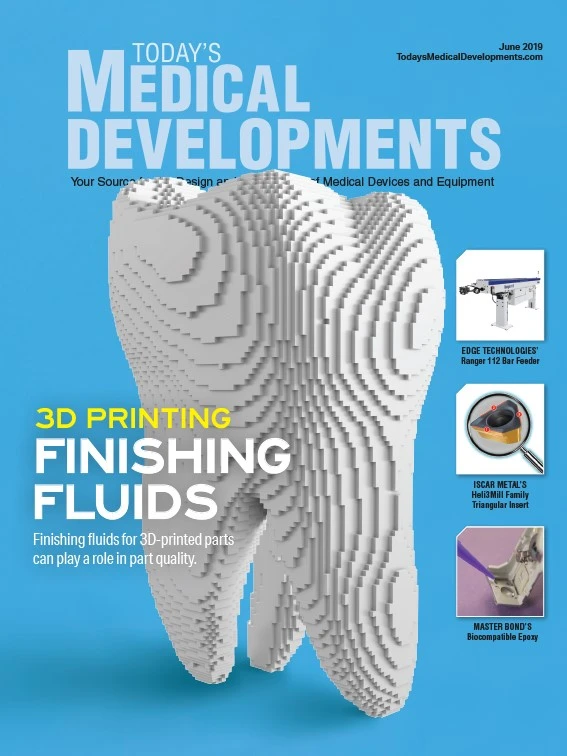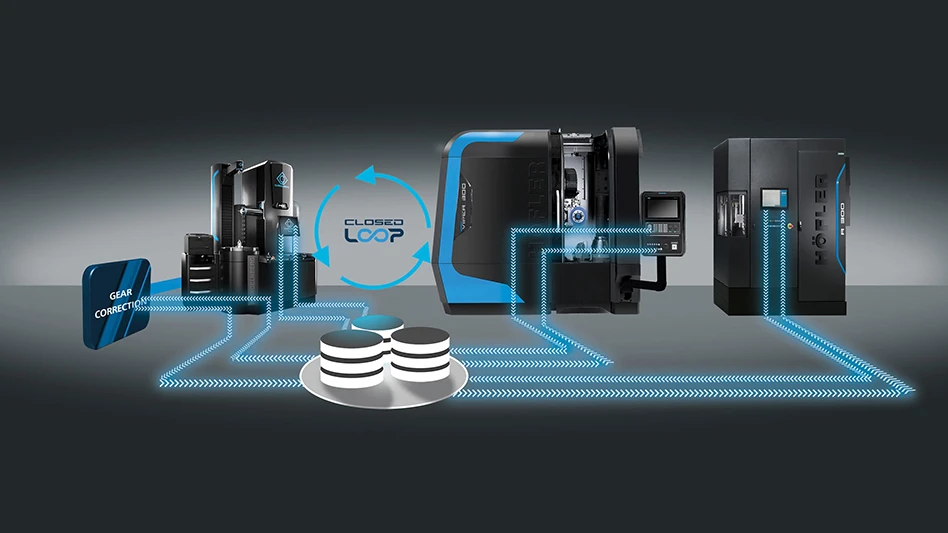
3D-printed plastic parts typically require post-production smoothing.
Although many have traditionally viewed 3D printing (3DP) – a subset of additive manufacturing (AM) – as something only used by hobbyists to make figurines or other decorative objects, 3DP has widespread acceptance within the medical device manufacturing industry for functional applications.
With the advancement of technologies and materials, 3DP is now regarded as a viable alternative to more conventional production methods such as subtractive or injection molding, in some instances eliminating the need for machining. It’s allowing medical device designers to create complex parts with intricate geometries that would otherwise be incredibly time-consuming or even impossible to make using more traditional methods.
Binder-jetting technology produces many 3DP medical devices, and the choice in binder-jetting finishing fluids plays a key role in process success.
Binder jetting
Several AM methods are used to make parts. Some, such as selective laser melting (SLM) and electron beam melting (EBM), are sophisticated processes requiring specialized equipment, complex safety procedures, and skilled operators. Binder jetting (BDJ) is a faster, more affordable alternative that does not employ lasers or electron beams to build parts, making it easier to use with minimal training.
BDJ makes three-dimensional parts from a computer aided design (CAD) file using a powdered material, typically plastic or metal, and a binding agent. Nozzles on the printer deposit an ultra- fine layer of powder on a build platform and application of liquid wax bonding agent binds the particles together. The print head continues to drop alternating layers of the powdered and the binding materials to form a solid part. The quality and precision of parts made with this 3DP process result in parts requiring minimal post-processing with excellent dimensional repeatability.
The 3DP process using BDJ may seem straightforward, however, it’s important to get the details right for the best results, including choosing the best finishing methods and fluids for the printing material used.
Fluid finishing
Historically, 3DP was restricted to producing plastic parts, and today, more than 80% are made using polymers. The layer-by-layer-process leaves some printed parts with a stepped or terraced surface, requiring smoothing to get a finished part.
Traditional methods of smoothing terraces, such as grinding, buffing, or sandblasting, are manual, time-consuming, and often leave particles behind. Today, smoothing fluids are available to vapor degrease, where users immerse unfinished parts in a fast-evaporating solvent vapor that slightly melts the surface of the plastic parts, levelling out irregularities and removing terraces for a smooth finish with no leftover particles or damage to the finished part.
For smoothing to work, it is necessary to understand the chemical composition of the polymer in use and to find the correct chemical solution for the application. Trained vapor degreasing experts have experience selecting smoothing fluids for specific types of 3DP polymers and can guide part designers through this process.

© LATSALOMAO | THINKSTOCKPHOTOS.COM
Metal 3D printing makes producing intricate designs easier.
Debinding fluids for metal parts
Until recently, metal 3DP was only used for prototyping or low-volume runs as it was too expensive and too slow for mass production, and overly complex for wide-scale use.
However, as technologies advance, metal 3DP is making its way to the manufacturing floor for higher production runs of end-use parts.
Metal 3DP employs the same layered- build process as plastic 3DP but with fine metal powders instead of polymers. Typical metal powders include stainless steel, tool steel, and other ferrous and nonferrous alloys.
The BDJ process uses alternating layers of the fine metal powder and a binding agent, typically paraffin wax, carnauba wax, or specialty polyethylene waxes, creating green-state parts which need to be cleaned and oven-sintered to make fully dense metal parts.
Binding agents serve a critical purpose in the forming process and must be removed to avoid contaminating the metal during sintering, yet it’s essential that some binder remain so the part maintains dimensional accuracy during sintering. A specialty engineered solvent can selectively remove some, but not all, of the binder. Selecting a debinding method is a balance between removing the binder in the shortest amount of time with the least amount of damage to the structure, which becomes fragile during the process.
Solvent extraction of the binder can be done in either the solvent vapor or the liquid phase in a vapor degreaser. Both rely on the solvent flowing through the pores, internal channels, and passageways of the structure to dissolve the wax, allowing the parts to be exposed to higher temperatures in the sintering furnace, reducing the time to a finished part.
New solvent blends speed the solvent debinding process without using n-propyl bromide, methyl pyrrolidone, polyethylene glycol, heptane, or trichloroethane. The debinding fluids boast low viscosity and surface tension ratings, are nonflammable, and are engineered for selectivity so the right amount of binder is removed without damaging the part structure. These debinding fluids, when used in a vapor degreaser, can also be distilled and reused.
Once the debinding fluid is fully removed from the part structure, parts are thermally sintered under high heat to bond the metal powder into a finished, solid mass while burning off the remaining binder. Parts then can be post-processed using standard metal finishing techniques such as grinding, cutting, or coating.
Finding a partner
Companies looking for help in determining the correct debinding fluid or method should consult with a critical cleaning partner that specializes in vapor degreaser debinding. Some fluid manufacturers have field engineers who conduct on-site audits to evaluate debinding methods and can also perform comprehensive in-lab tests with sample parts to ensure cleaning and debinding success.
Post-processing using specialty fluids and solvent-based treatments help make plastic and metal 3DP viable options within the medical device industry, and it’s important to work with a partner that has specialized experience and expertise in solvent technology to recommend the fluids and methods that will work best.
MicroCare Medical
https://medical.microcare.com

Explore the June 2019 Issue
Check out more from this issue and find your next story to read.
Latest from Today's Medical Developments
- MedTech Innovator welcomes five new industry partners
- First Article Inspection for quality control
- The manufacturing resurgence is here – are you ready?
- Workholding solutions for your business
- ZOLLER events will showcase the company’s cutting-edge innovations
- THINBIT’s MINI GROOVE ‘N TURN Acme threading inserts
- CMMC Roll Out: When Do I Need to Comply? webinar
- Metabolic research uses Siemens gas analyzers to deliver results with 99.9999% resolutions





